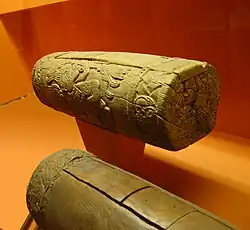
A slit drum or slit gong is a hollow percussion instrument. In spite of its often being called a drum, it is not a true drum (because it lacks a drum head) but an idiophone, usually carved or constructed from bamboo or wood, in the form of a mostly closed hollow chamber with one or more slits in it. It is played by striking near the edge of the slit. In some designs, the slit is a single straight line; in others, the slit is used to create one or more "tongues", achieved by cutting three sides of a rectangular (or similar) shape and leaving the fourth side attached. Most slit drums have one slit, though two and three slits (often resembling an "H" and thereby forming two tongues) occur. Tongues of different areas or thicknesses will produce different pitches. Slit drums are used throughout Africa, Southeast Asia, and Oceania. In Africa such drums, strategically situated for optimal acoustic transmission (e.g., along a river or valley), have been used for long-distance communication.[1]
The ends of a slit drum are closed so that the shell becomes the resonating chamber for the sound vibrations created when the tongues are struck, usually with a stick or mallet. The resonating chamber increases the volume of the sound produced by the tongue and presents the sound through an open port. If the resonating chamber is the correct size for the pitch being produced by the tongue, which means it has the correct volume of airspace to complete one full sound wave for that particular pitch, the instrument will be more efficient and louder.
The people of Vanuatu cut a large log with "totem" type carvings on the outer surface and hollow out the center leaving only a slit down the front. This hollowed out log gives the deep resonance of drums when hit on the outside with sticks.
.jpg.webp)
List of slit drums
African
- Alimba – Zairean (Democratic Republic of the Congo)
- Ekwe – Igbo (Nigeria, Equatorial Guinea)
- Ikoro – Igbo (Nigeria, Equatorial Guinea)
- Krin (log drum) or Kolokolos – Guinea
- Lokole – Congo Basin
- Lukombé[2] – (Democratic Republic of the Congo)
- Mondo – West Africa
- Mukoku – Yaka people (Congo)
Austroasiatic
Austronesian
- Agung a Tamlang – Maguindanaon (Philippines)
- Atingting kon - Ni-Vanuatu (Vanuatu)
- Kagul – Maguindanaon (Philippines)
- Kentongan – Javanese (Indonesia), used to wake people for sahur meals on Ramadan
- Kulkul – Balinese (Indonesia)
- Lali – Fijian (Fiji)
- Pahu – Māori (Aotearoa / New Zealand)
- Pate – Samoa, Cook Islands, and other parts of Polynesia
- Tagutok (Philippine) – Maranao (Philippines)
- To'ere – Tahitian (Tahiti)
- Garamut – Papuan (Papua New Guinea)
Mesoamerican
Modern
- Gato – 20th-century American, originally a brand name, later generic[3]
- Tongue drum
Sinitic

The wooden fish works like a slit drum but is rarely classified with the other slit drums.
Gallery
 Two Aztec slit drums, called teponaztli. The characteristic "H" slits can be seen on the top of the drum in the foreground.
Two Aztec slit drums, called teponaztli. The characteristic "H" slits can be seen on the top of the drum in the foreground. Wooden slit drums from Vanuatu, Bernice P. Bishop Museum
Wooden slit drums from Vanuatu, Bernice P. Bishop Museum Ekwe drum of the Igbo people
Ekwe drum of the Igbo people Banda-Yangere animal-shaped slit drum
Banda-Yangere animal-shaped slit drum
See also
Notes
- ↑ Hart, Mickey; p. 52
- ↑ "Lukombé (slit drum) | Tetela, Kasai or Kusu". The Metropolitan Museum of Art. Retrieved 18 February 2023.
- ↑ "Gato drum". Metropolitan Museum of Art. Archived from the original on 9 March 2016. Retrieved 29 June 2023.
References
External links
- Collins Rhythmcraft page on slit drums
- Drum Museum Siebenborn, Infos about antique slit drums and hand drums from Africa and New Guinea
- Beauty of Life Blog – A few examples of wooden slit gongs from Asia, including elephant bells.